The unofficial slogan of most big businesses and top brands should be, “Look before you leap.”
So, marketers and agencies working for a large company or brand name product should probably take a much, much closer look – at Nike’s decision to make Colin Kaepernick the spokesperson in a campaign that says, “Believe in something. Even if it means sacrificing everything.”
Why?
Because taking a stand on a controversial political issue to commemorate the 30th anniversary of the brand’s slogan, “Just Do It,” probably wasn’t a rash or impulsive decision.
In other words, the decision-makers at Nike probably looked before they leaped.
How can we tell?
First, Nike didn’t launch this campaign back in the fall of 2016, when the San Francisco 49ers quarterback first sat and later knelt during the national anthem to protest police brutality and racial inequality in the United States.
In fact, the brand didn’t announce its advertising campaign until two years later – on Tuesday, September 4, 2018. This meant the company and its advertising agency, Wieden + Kennedy, had plenty of time to make a data-driven, considered decision before doing anything.
Was waiting two years before taking a stand on a controversial political issue old news?
Well, “Nike News” was ranked #2 and “Nike Stock” was ranked #3 in the Daily Search Trends on September 4 – behind “Bob Woodward,” but ahead of “Bobby Brown” – all of which got more than 1 million searches that day, according to Google Trends.

Second, Jeetendr Sehdev, the author of “The Kim Kardashian Principle“, which was published on March 21, 2017, recently told Janet Comenos of Adweek that a guiding principle of his best-selling book is to “sacrifice everything if you believe in something,” which is strangely similar to the tagline for Nike’s latest campaign.
Sehdev said:
“That was my exact vision for the book: to not only empower leading marketers to think differently about building brands but also to change the culture.”
So, one or more of the decision-makers at Nike or Wieden + Kennedy had plenty of time to have read Sehdev’s book and discuss its guiding principles with his or her colleagues or client before launching their campaign.
Third, back in April 2017, Pepsi pulled a controversial ad featuring Kendall Jenner, “Live for Now,” after one day of intense criticism from people who said it trivialized the widespread protests against the killings of black people by the police.
At the time, Pepsi released a statement, saying:
“Pepsi was trying to project a global message of unity, peace and understanding. Clearly we missed the mark, and we apologize. We did not intend to make light of any serious issue. We are removing the content and halting any further rollout.”
In contrast, Nike stood firm the day after the brand publicly announced that its new campaign would feature Kaepernick, despite some protesters cutting Nike logos off their socks and burning their Air Jordans and uploading their photos and videos to social media.
More significantly, Nike held its ground even after its stock dipped 3.2 percent on Tuesday, September 4. This indicates that Nike executives, as well as the brand’s marketers and agency, didn’t think they had missed their mark.
Well, we’ve now had about two weeks to evaluate the initial results of Nike’s “Dream Crazy” campaign.
So, were the brand’s executives, marketers, and agency crazy? It may still be too soon to tell, but there are some early indicators that they were crazy like a fox.
For example, their Twitter ad, “Don’t ask if your dreams are crazy. Ask if they’re crazy enough. #justdoit,” now has 35.5 million views, making it the brand’s top Twitter video of all time.
Their YouTube ad, “Nike – Dream Crazy,” now has 26 million views, making it one of the brand’s top 5 YouTube videos of all time.
And their Instagram ad, “Don’t ask if your dreams are crazy. Ask if they’re crazy enough. #justdoit,” now has 9 million views, making it the brand’s top Instavid of all time.
It’s worth noting that Nike has uploaded a total of 32,900 videos to social video platforms since October 20, 2005, according to Tubular Labs.
So, the “Dream Crazy” campaign’s initial video performance is unmatched by any of the brand’s earlier social video campaigns.
You’ll get another picture of just how unprecedented this new campaign has been by looking at Google Trends.
Even with only partial data available for September 2018, search interest on Google for Nike (footwear manufacturing company) is about 2.5 times higher than it’s ever been since 2004.
And search interest on YouTube for Nike (footwear manufacturing company) is almost 1.6 times higher than it’s ever been since 2008.
And, it’s also worth noting that Google’s Brand Lift solution uses organic searches on both Google.com and YouTube.com to measure the impact that a video campaign has on creating interest in a brand.
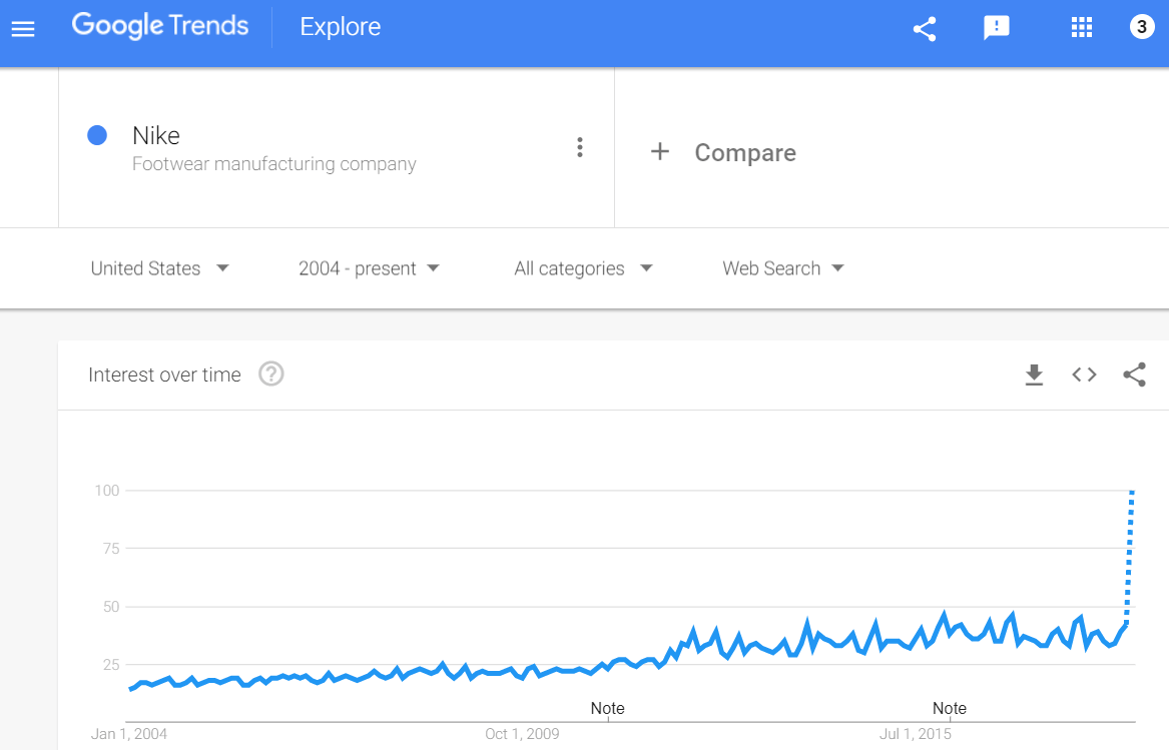
Finally, I conducted a search for Nike using Yahoo last week, and I saw news at the top of the search engine results page (SERP).
On September 12, this included a recent headline from MarketWatch, “Nike’s online sales jumped 31% after company unveiled Kaepernick campaign, data show.”
And the story’s subhead reads, “Fears of a hit appear overblown as consumers, brand experts and analysts cheer an edgy and risky marketing move.”
You’ll also see another headline from MarketWatch, “Nike upgraded in face of Colin Kaepernick advertising controversy.”
And the story’s subhead reads, “Innovation is paying off and the Jordan brand is gaining momentum, analysts say.”
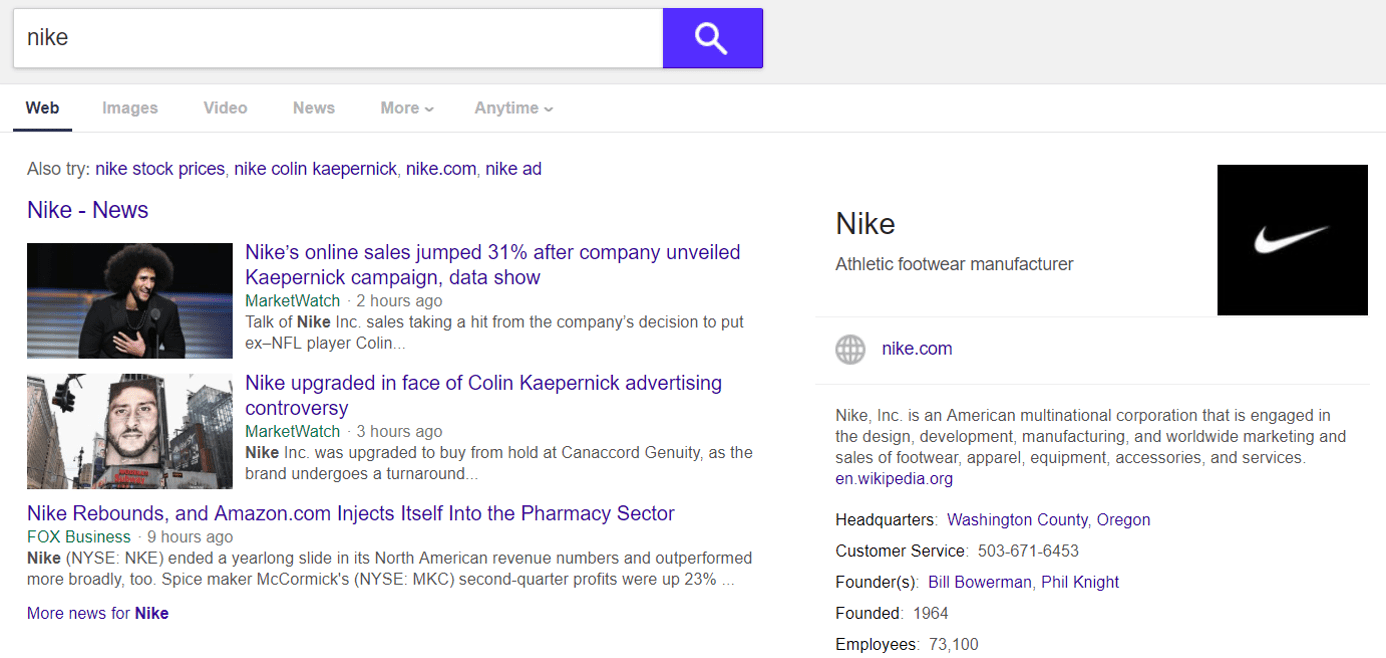
So, based on the early returns from Nike’s latest campaign, I’d say that it’s probably time for you to ask: “Should we start taking a stand on controversial or political issues?”
But, before you rush out and “Just Do It,” I’d still recommend that you continue to “Look before you leap” by asking six old-fashioned (a.k.a time-tested) questions – and getting hard answers – ahead of time.
1. Who Is Our Target Audience?
Now, market segmentation has been a strategic decision for most big businesses and top brands since the 1920s.
But, in today’s increasingly polarized political climate, you need to be crystal clear about who your target audience is before taking stances on hot-button issues.
For example, Patagonia, which was founded by environmental activist Yvon Chouinard in 1973, spent $700,000 to run its first TV commercial in its 44-year history last year in response to President Trump’s request to review 28 of America’s national monuments.
The brand also uploaded “Why Patagonia is Fighting for Public Lands” to its YouTube channel on August 20, 2017.
After this YouTube video was uploaded, you didn’t see any photos or videos of Patagonia’s customers burning their clothes for climbing, skiing, snowboarding, surfing, fly fishing, paddling, or trail running.
Why?
Because Patagonia’s customers love the outdoors and share the brand’s strong point of view about protecting and preserving the environment.
So, who was Nike’s target audience for the “Dream Crazy” campaign?
A story by Darren Rovell on ESPN, said it was 18- to 29-year-old males. And a Harris poll of 2,026 people conducted last week for ESPN found that 29 percent of 18- to 29-year-old males said they would purchase more products from the brand.
However, ESPN also reports that 21 percent of people surveyed said they would stop buying Nike products.
John Gerzema, CEO of the Harris Poll, told ESPN:
“Nike took a strategic risk to alienate some customers in order to appeal to their core base of 18- to 29-year old males. It was a calculated move to become a more polarizing brand and it seems to have worked.”
Compared to a poll taken 9 months earlier, Nike’s “Dream Crazy” campaign boosted how positively the 18- to 29-year-old age group thought of the brand by 6 percentage points, helping Nike to catch up to Under Armour and Adidas.
And according to a story by Sarah Vizard in Marketing Week, new surveys by Toluna of 1,000 consumers in the U.K. and 1,000 consumers in the U.S. have found that younger consumers , as well as those who are Black/African American or Asian, are far more likely to view the “Dream Crazy” campaign favorably than older, white consumers, and it is more likely to get them to buy from Nike in the future.

As Mark Ritson, Marketing Week’s columnist, observed:
“Nike wins big on brand positioning with this campaign. But it loses half on targeting. In that sense it’s one of the boldest branding plays of the year. The big question is whether the massive surge in notoriety, salience, revitalization and meaning across half Nike’s market will offset the negativity among the other half.”
2. What Is Our Campaign’s Message?
Marketers and their agencies also need to craft an authentic and powerful message for their brand.
This message should lie at the intersection of their audience’s passion points and their brand’s value proposition.
So, what can a brand say to consumers to earn their loyalty?
Depending on your brand’s identity, there are different ways to pique your audience’s interest and make them care about your message.
Guy Kawasaki asked me to contribute a couple of pages on this topic to his book, “Enchantment“, and I identified four ways to provide intrinsic value to your viewers. You can:
- Inspire your audience with emotional and relatable stories, like “Just Do It: Serena Williams.”
- Educate your audience with useful information. like “Refugees Find A Home At Rhino Foods | Ben & Jerry’s.”
- Enlighten your audience with documentaries, like “How evian plans to reach 100% recycled plastic in bottles.”
- Entertain your audience by making them laugh or sharing spectacular content, like “Turkish Airlines: Safety Video with The LEGO Movie Characters.”
The key to selecting the best advertising or content marketing strategy is choosing the strongest core message and most appropriate tone for your campaign.
Sometimes, you don’t hit the ball out of the park. For example, watch “Burger King | Whopper Neutrality.”
As the video’s description explains:
“The repeal of Net Neutrality is a hot topic in America, but it can be very difficult to understand. That’s why the BURGER KING brand created WHOPPER Neutrality, a social experiment that explains the effects of the repeal of Net Neutrality by putting it in terms anyone can understand: A WHOPPER sandwich.”
In case the connection wasn’t obvious, Burger King added that the brand “believes the Internet should be like the Whopper sandwich: the same for everyone.”
Did this message resonate?
Well, “Burger King | Whopper Neutrality” got almost 4.6 million views – which ranks 65 out of 11,900 videos uploaded to social video platforms all time.
The average Burger King video on YouTube gets 286,000 views, so it performed well about average, if not well enough to top the charts. And “Whopper Neutrality” got 127,000 Likes vs. 10,000 Dislikes. So, that’s a positive ratio.
In other words, it probably helped the brand. But, it might have helped even more if the topic wasn’t so difficult to understand or Burger King’s customers cared more passionately about Net Neutrality.
3. Where Will We Run Our Campaign?
Marketers and brands also need to think long and hard about where they will run a campaign.
As I mentioned above, Nike uploaded versions of “Dream Crazy” to Twitter, YouTube, and Instagram.
The brand also uploaded their new ad to the Nike Football page on Facebook on September 5. And it briefly got 28,600 views before it was removed or only made visible to an audience that I’m not in.
“Nike – Dream Crazy” was also uploaded the following day to the Nike Taiwan and Nike Hong Kong pages on Facebook, where they got 248,000 and 149,000 views respectively.
If Nike pulled its ad from Facebook, then you should probably think twice before uploading controversial or political videos to all four of the major social video platforms.
And you should also read the article by Kurt Wagner and Rani Molla in Recode, which reports that Facebook disabled 583 million accounts in Q1 2018, down from 694 million accounts in Q4 2017, a decrease the company attributes to its “variability of our detection technology’s ability to find and flag them.”
For example, Facebook removed 2.5 million pieces of “hate speech” in Q1 2018, 56 percent more content than the 1.6 million pieces it removed in Q4 2017.
However, this content was primarily identified by humans; only 38 percent of the hate speech Facebook removed in Q1 of this year was first identified by algorithms.
Now, that’s an improvement over 23.6 percent in Q4 of last year, but it’s still much smaller than some of the other content categories that Facebook looks for (e.g., nudity and terrorism-related content).
That makes sense, because “hate speech” is much more subjective than nudity. What one person might describe as hate speech, another might describe as free speech.
The fact that Facebook still has trouble detecting it without human help shows that this problem isn’t likely to go away anytime soon.
“Hate speech is really hard,” said Alex Schultz, Facebook’s VP of analytics, in a briefing with reporters. “There’s nuance, there’s context. The technology just isn’t there to really understand all of that, let alone in a long, long list of languages.”
So, maybe the relatively limited presence of “Dream Crazy” on Facebook is the “canary in the coal mine” for other big businesses and top brands.
If you’re planning to take a stand on a controversial or political issue, perhaps you shouldn’t use Facebook until it makes significantly more progress identifying and removing “hate speech.”
4. When Should We Use Pre-Testing?
Now, if you’ve ever had a tough time making the business case for pre-testing, then the perfect time to start is when you’re about to take a stand on a controversial or political issue.
It’s a pretty safe bet that Nike and Wieden + Kennedy used pre-testing ahead of time and had a pretty clear picture of how their target audience would react to their new “Dream Crazy” campaign.
What would pre-testing have told them?
Well, we don’t know for sure, but a recent article by Adrianne Pasquarelli in Ad Age reported on the early tracking analysis of the “Dream Crazy” ad by Morning Consult.
The firm surveyed roughly 2,000 viewers who “dial-tested” the video by weighing in on their favorite parts. And according to Morning Consult:
“The results indicate that black Americans, Democrats and younger generations were much more receptive to Kaepernick’s involvement and message than white Americans and Republicans. Additionally, Nike users had a more favorable view throughout than non-Nike users.”
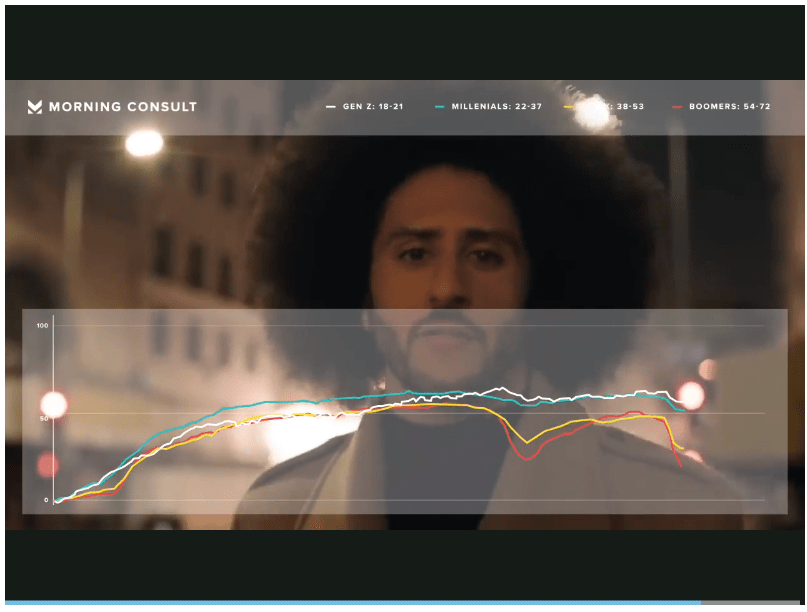
There are other pre-testing solutions that Nike could have used.
Back in June, I wrote about two companies that are using artificial emotional intelligence to enable big businesses and top brands the ability to pre-test new video campaigns:
- Realeyes, an emotion tech company that spun out of Oxford University in 2007.
- Affectiva, an emotion measurement technology company that spun out of MIT’s Media Lab in 2009.
For example, Realeyes looked at the sportswear giant’s controversial campaign in more detail to uncover what consumers really thought. The results are surprising:
- Kaepernick wasn’t the sports star that generated the most negative facial expressions by people watching the ad.
- Negative emotions among people who disliked the ad actually peaked during the scenes showing tennis star Serena Williams.
- Most of the negative emotional reactions came from Nike’s narrative rather than from Kaepernick.
- Men had more negative emotions; women were more positive toward the ad.
- There was no old vs young split; the middle-aged demographic was the least positive.
Since then, I’ve been working with a Fortune 500 company with a portfolio of iconic brands. It uses four other pre-testing solutions:
- Google’s Consumer Surveys.
- Facebook’s Creative Compass.
- Nielsen’s Branded Content Effectiveness Studies.
- Kantar Millward Brown’s Branded & Sponsored Content Evaluation.
So, despite what Nike’s slogan says, you shouldn’t “Just Do It.”
Before your business or brand takes a stand on a controversial or political issue, you should use pre-testing to “Look before you leap.”
5. Why Can’t We Avoid Taking a Stand?
Fortunately, there is a lot of research available to help you provide a data-driven answer to the question: “Why can’t we avoid taking a stand?”
For example, a survey by Sprout Social, which was published on January 9, 2018, found that two-thirds of US Internet users want brands to take a stand on social and political issues.
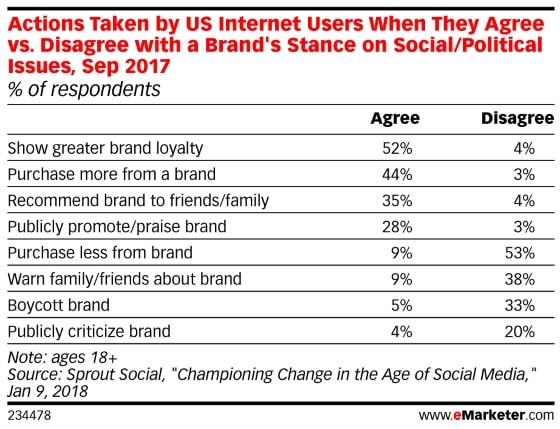
The Sprout Social survey also found that 52 percent of internet users said they would show greater brand loyalty and 44 percent said they would purchase more from brands when they agreed with their social or political views.
But, 53 percent said they’d purchase less from brands and 33 percent said they’d boycott a brand that didn’t share their values. So, pick your fights carefully.
For example, a July 2018 poll by Morning Consult found 46 percent of U.S. adults opposed NFL players kneeling during the anthem. But there were stark differences in opinion by political affiliation and age.
Republicans were 81 percent in opposition, while just 20 percent of Democrats opposed the protest. And only 24 percent of respondents ages 18 to 29 thought kneeling was unacceptable.
This figure rose with age, climbing to 55 percent for those ages 45 to 54 and to 69 percent for those 65 and older.
But as I’ve already pointed out, Nike’s target market wasn’t older Republicans, which lessened the potential impact of a boycott. But, it didn’t eliminate the risk altogether.
Nevertheless, the backlash may have been worth it.
As Allen Adamson, the co-founder of marketing consulting firm Metaforce, told Diana Pearl from Adweek, a brand must take a stand in today’s world — even if it means alienating some of its customers — in order to remain relevant as well as to capture consumers’ attention:
“Brands that try to please everybody become invisible in today’s marketplace. No matter what you stand for, you’re going to ruffle feathers and upset users. Some consumers will disappear, but others will become even more passionate. It’s better to have people passionate one way or the other than people ignoring you.”
6. How Will We Measure Our Results?
This brings us the final and most important question you need to ask before taking a stand on controversial or political issues:
How will we measure our results?
As we’ve seen from the data cited above, you can use “views” as a metric. But, I wouldn’t use it as a key performance indicator (KPI).
Why?
Well, ask your marketing or agency people, “How many views do we need to sell a sneaker?” And don’t be surprised if they can’t give you an answer.
So, some journalists and bloggers may still think that millions of views as an indication of success, but all of us know better. (You can use advertising to boost the number of views that your video gets. So, if your video gets more views, then maybe your brand had a bigger budget.)
You can – and should – pre-test your ad campaign. But the samples for pre-tests are relatively small. So, they aren’t the best way to measure results.
YouTube, Facebook, and Twitter offer advertisers Brand Lift studies, which enable you to ask your target audience questions like:
- Do you recall seeing an ad for [brand] online or on a mobile device in the last 2 days?
- Which of the following comes to mind first when you think of [brand]?
- Will you recommend [brand] to a friend?
- Have you heard of [brand]?
- Will you buy/consider [brand] the next time you shop for [category]?
For example, Google’s Brand Lift solution measures brand awareness, ad recall, consideration, favorability, and purchase intent by isolating a randomized control group (a.k.a. holdout group) that isn’t shown your video ad and an exposed group that does see your ad on YouTube.
About a day after seeing (or not seeing) your video ad on YouTube, Google delivers a one-question survey to both groups.
Since the only effective difference between the two groups is whether they saw your video ad on YouTube, Google can accurately determine the lift attributed to your campaign.
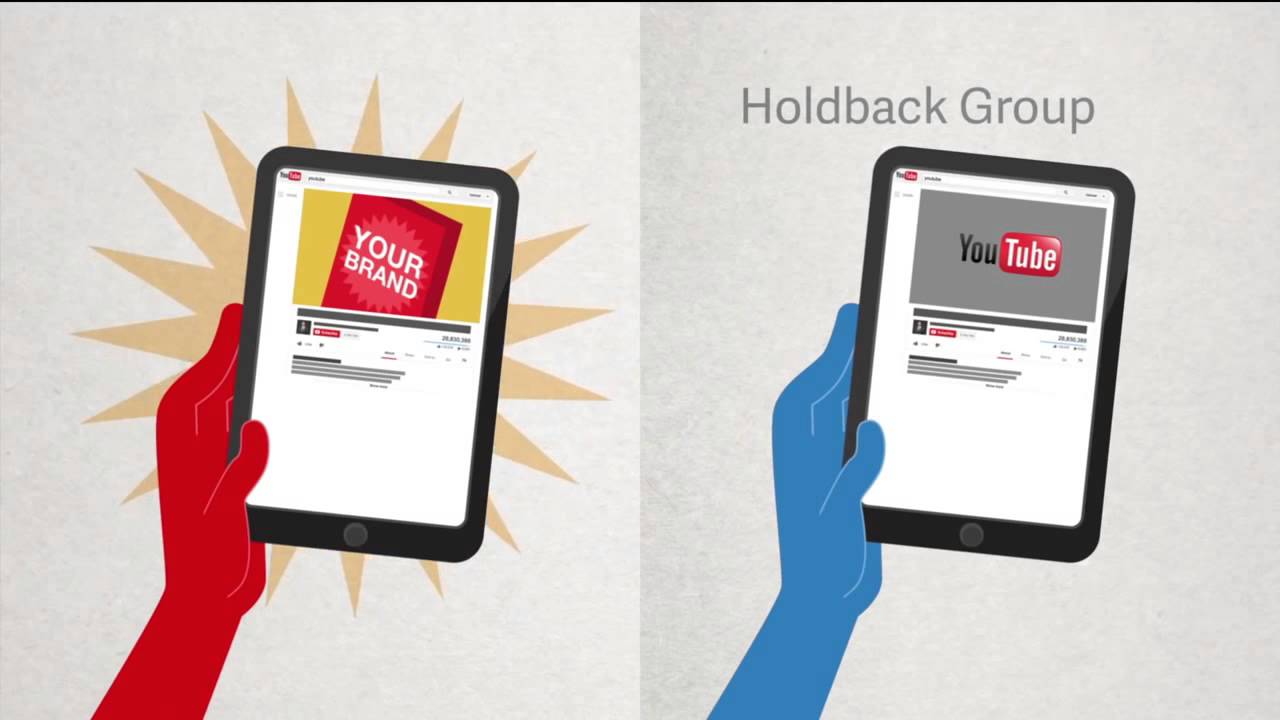
Google’s Brand Lift solution also measures the impact your campaign has on creating interest in your brand by using organic searches on both Google and YouTube.
Similar to surveys, Google randomly picks a group that saw your ad and a control group that didn’t see your ad.
They then compare the organic search behavior of both groups, looking at how often your target audience searches for keywords related to your brand or campaign. The difference in searches can then be attributed to your campaign.
But, for Nike’s “Dream Crazy” campaign, the metric that mattered the most was sales.
The key data was provided by Edison Trends, which disclosed that online sales of Nike products dropped the Sunday of Labor Day weekend and rebounded on Monday and Tuesday in both 2017 and 2018. However, this year online sales of Nikes rebounded much higher.
Edison Trends said:
“This past Labor Day there was speculation that Nike’s Colin Kaepernick ad campaign could lead to a drop in sales. Edison Trends investigated the sales over the holiday and its research, at this point, does not seem to support that theory. In fact, Nike sales grew 31 percent from Sunday through Tuesday over Labor Day this year, besting 2017’s comparative 17 percent increase.”

Yes, the surveys by Morning Consult, the Harris Poll, and Toluna provided context, but the arguments ended when everyone found out that the “Dream Crazy” campaign had sold more sneakers.
So, to the extent that it’s possible for your business or brand, measure the impact of taking a stand on a controversial political issue in cold, hard cash.
Or, as David Ogilvy wrote back in 1983 in his classic book, Ogilvy on Advertising:
“I do not regard advertising as entertainment or an art form, but as a medium of information. When I write an advertisement, I don’t want you to tell me that you find it ‘creative.’ I want you to find it so interesting that you buy the product.”
In other words, continue to “Look before you leap.” But, based on the early returns from Nike’s latest campaign, it’s probably time for your business or brand to take a stand on controversial or political issues.
More Resources:
- 3 Valuable PR Lessons You Can Learn From the Nike Controversy
- Building Links Through Social Responsibility & Taking a Stand
- 7 Powerful Content Secrets That Move People to Take Action
Image Credits
Screenshots taken by author, September 2018





![AI Overviews: We Reverse-Engineered Them So You Don't Have To [+ What You Need To Do Next]](https://www.searchenginejournal.com/wp-content/uploads/2025/04/sidebar1x-455.png)